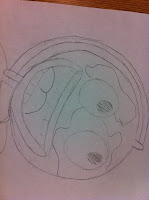Artist Rene Magritte, a surreal artist, was known for
combining objects that don’t go together.
He would paint an umbrella with a glass of water, raining men with
bowler hats, a man with a pumpkin for a head, or a train leaving a
fireplace. Confused by these images and
ideas? Exactly! The students were not told the lesson, but
told to write down some nouns that DON’T go together on a scrap of paper;
bumble bees and coffee, rocks and pencils, soda and dandelions, unicorns and
toenails. Brainstorming together is
challenging, but produces great results. Combining these images is a way for
the students to create and understand surrealism. The students were asked to
pick their favorite images and draw them with pencil.























